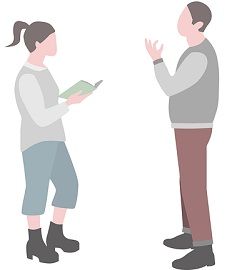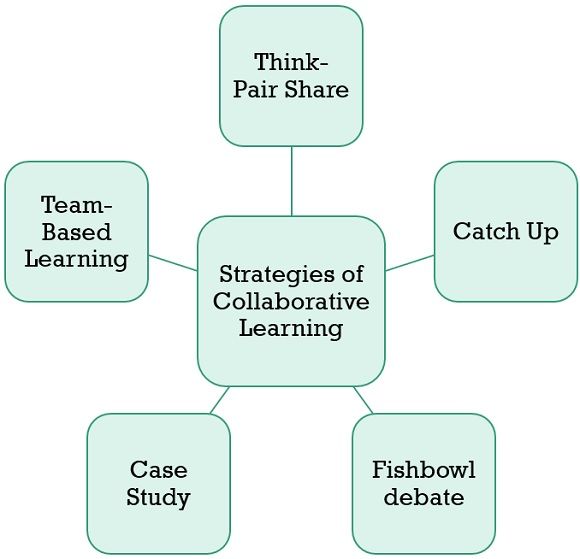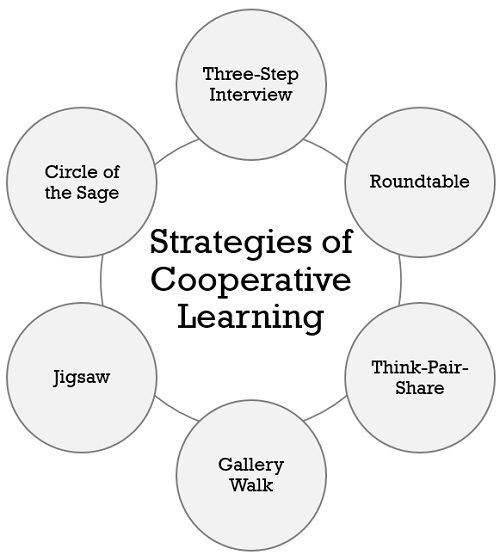 Cooperative Learning and Collaborative Learning are commonly used in group activities aimed to attain a common objective. In collaborative learning, it is the students who organize their efforts among themselves. In short, it is group structured. On the other side, in cooperative learning, students are divided into groups and the teacher assigns specific roles and tasks to each student, and so it is a teacher-structured activity.
Cooperative Learning and Collaborative Learning are commonly used in group activities aimed to attain a common objective. In collaborative learning, it is the students who organize their efforts among themselves. In short, it is group structured. On the other side, in cooperative learning, students are divided into groups and the teacher assigns specific roles and tasks to each student, and so it is a teacher-structured activity.
While collaborative learning is a voluntary activity, wherein those students who are genuinely interested can participate, cooperative learning is a compulsory activity for all the students who are present in the classroom and so they have to participate to reach the goal.
What is Learning?
Learning means acquiring experience, knowledge, skills, and values to understand what and how to do something by accumulating all the information gathered by us from various sources and then applying it. It is a process that shapes and defines an individual’s personality, attitude and behavior. Indeed, it tends to develop socially acceptable behavior in a person.
Also Read: Difference Between Learning and Education
In this post, we are going to talk about the difference between collaborative learning and cooperative learning.
Content: Collaborative Learning Vs Cooperative Learning
Comparison Chart
| Basis for Comparison | Collaborative Learning | Cooperative Learning |
|---|---|---|
| Meaning | Collaborative learning is a form of learning wherein learners are divided into several groups to explore questions and develop their understanding and knowledge on the subject. | Cooperative learning is a method of instruction wherein students work in small teams to achieve a shared learning goal, under the guidance of the instructor. |
| Orientation | Student Oriented | Teacher Oriented |
| What is it? | Structure of Interaction | Philosophy of Interaction |
| Roles and Responsibilities | Negotiated and agreed | Predefined |
| Presence of Teacher | May or may not be present. | Present and more active. |
| Evaluation of Outcome | Performed by the students | Performed by the teacher |
| Appropriate for | Adult and mature students | Kids and Youngsters |
| How solution to a problem is found out? | By mutual cooperation, involvement, and combined effort of the learners. | Various aspects of the problem are determined, and learners are given the responsibility of finding a solution to different aspects which is then integrated to solve the problem. |
| Structure of Learning system | Informal, flexible, and less structured | Formal, directive, and structured. |
| Source Material | Students share source material among themselves. | Supplied by the teacher to the students. |
Definition of Collaborative Learning
When the students come together and work as a team on a project, then that form of learning is termed collaborative learning. In this form of learning:
- The learners are grouped or paired together, to achieve a common goal.
- The learners are responsible for each other’s learning, along with their own learning.
Collaborative Learning implies a type of learning wherein two or more than two persons come together for learning purposes. The learners share their knowledge, make use of each other’s resources and praise/disagree with each other’s views, and guide one another. In this way, sharing knowledge, understanding, problem-solving, and the collective effort of the group to develop something new is called collaborative learning.
Collaborative Learning can take place primarily when the communication between learners is face to face. However, with the emergence of advanced information and communication technology methods, such as online forums, chat rooms, video conferencing, collaborative learning is possible through other modes also. It includes:
- Collaborative writing
- Cumulative problem solving
- Debate
- Group discussion
- Group study
- Group project, etc.
Also Read: Difference Between Debate and Group Discussion
Definition of Cooperative Learning
Cooperative Learning is a form of learning which is based on mutual cooperation. In this method, each member of the group is made in charge of the academic performance of the other member, by the teacher.
Hence in order to make the other students understand the content, each member of the group uses their knowledge and skills, which means that each member is responsible not only for their own learning but also for the learning of their fellow mates.
- The group may consist of people with similar or different age groups, intellectual abilities or competencies, to attain learning objectives.
- It involves the pedagogical use of small groups of learners so that they can come together and work.
In cooperative learning, small groups of learners are formed as instructed by the teacher, with an aim of maximizing one’s and each other’s learning. Thereafter, they work on the assignment, till each member of the group understands and completes it successfully.
In this, the participants work together for mutual benefits, such that all the members of the group acquire something from each other’s efforts.
Also Read: Difference Between Active and Passive Learning
Key Differences Between Collaborative Learning and Cooperative Learning
Read out the points to understand the difference between collaborative learning and cooperative learning:
- Collaborative Learning refers to the educational and teaching method in which groups of students work together to solve a problem, or create a product, develop understanding or complete a task. On the other hand, Cooperative learning is an effective teaching method in which students work together in small groups and each student’s abilities are different and a number of activities are used to improve the student’s understanding of the subject.
- As collaborative learning is student-centered, the responsibility of learning lies with the student and the teacher may not be there to guide and monitor the students, whereas in cooperative learning it is the responsibility of both teacher and student, to carry out learning activities and so it is teacher-centered.
- Collaborative Learning is a philosophy of interaction, in which the learners are responsible for their learning as well as respect the ability and contribution of the fellow. In contrast, Cooperative Learning is a structure of interaction that is meant to assist in the attainment of goals by way of working together in groups. In this, the teacher helps the group in reaching the goal.
- The idea of collaborative learning and cooperative learning is originated from the concept of Zone of Proximal Development (ZPD). The ZPD concept is coined by Lev Vygotsky. However, they were introduced in different continents, i.e. Collaborative Learning is propounded by George Jordan at the University of Glasgow in Britain, whereas Cooperative Learning was propounded by two brothers – David Johnson and Roger Johnson at the University of Minnesota in America.
- The teacher may or may not be present at the time of group activity in collaborative learning. However, if they experience any difficulty or have any doubts, they can contact the teacher. Hence, the activity can be performed even without the presence of a teacher and the assistance of the teacher can be requested whenever required. Contrastingly, in cooperative learning, the teacher guides students by instructing them and splitting them into groups and assigning roles to the learners. Further, the members of the group differ in their abilities, so the teacher is quite active.
- While collaborative learning is best for adult and mature students, cooperative learning is appropriate for young, school-going children.
- In collaborative learning the students are independent and responsible for their own learning, they are the ones who evaluate the outcomes of the learning exercise. Hence, the students are the ones who assess their own individual and group performance. Conversely, in cooperative learning, it is the teacher who evaluates the activity performed by the students of different groups, for which students submit their work at the end of the lesson for the purpose of evaluation.
- Because collaborative consists of open-ended and complex tasks, that do not have any specific answer, it is informal, flexible, and less structured, where the teacher’s role is more of a facilitator of the group action. Conversely, cooperative learning is formal, structured, and directive, wherein students work together to reach a common goal, under conditions framed by the teacher.
- In collaborative learning, students share their study resources among themselves, so as to accomplish the task or complete the activity. On the other side, teachers supply information to the students, i.e. fundamental information to read and analyze. Further, the students work on that information, develop their knowledge and help their peers in applying the knowledge.
Strategies of Collaborative Learning
Think-Pair-Share: A problem is presented before the students by the teacher which is associated with high order thinking abilities like analysis, synthesis, evaluation, and construction. A small amount of time is given to the students so that they can think and respond to the given problem. Thereafter they share their answers with their partners, and listen to other’s answers and discuss it. Lastly, all the groups share their outcomes during the discussion.
Catch Up: In this method, at the time of taking the lecture, the teacher stops suddenly and asks the students to compare their notes with those of other students and ask questions (if any) on the doubtful points for clarification.
Fishbowl debate: Three groups of learners are formed. The group on the right side is in support of the topic, while the group sitting on the left is against it. The group sitting in the middle is given the task to write down the thoughts of both and ascertain which group has stated facts, valid reasons more effectively than the other. Lastly, they are asked to present the report generated before the class.
Case Study: 5-6 case study proposals are prepared by the teacher, with similar levels of difficulty. The proposals are assigned to different groups and the groups are provided proper time for analysis. Thereafter, a progress report is demanded by the teacher. Lastly, once the work is completed, the report is presented before the class.
Team-Based Learning: Learners are divided into various groups by the teacher and a particular task is assigned to them. And once the task is completed, they need to appear in an examination at group level like a quiz. And based on the group consensus they have to answer the question and name the member who has given that answer. Finally, the teacher explains the difficulties and resolves all the doubts that the students have.
Strategies of Cooperative Learning
Three-Step Interview: In a three-step interview, pairs of students are formed and the teacher may ask students to read the matter in advance. There are three steps involved in it:
- Step1: One student is interviewed by another student within the given time.
- Step2: Roles are reversed and the interview is conducted again, in which the same questions or questions of similar nature are asked.
- Step 3: The learning team comprises of two pairs wherein the students after conducting the interview share the key insights with each other.
Roundtable: In this strategy, students sit in a circular manner around a roundtable and each student responds turn by turn, to a question or problem for which they speak up for their opinion or idea while noting down the points on paper.
The teammates are allowed to say pass if their thoughts are standstill, however, they are advised not to skip any question. It involves brainstorming, reviewing, or learning a skill with the help of a single sheet of paper and pen.
Think-Pair-Share:
- Think: In this activity, the teacher asks a question to the students, particularly the ones that demand analysis, evaluation, synthesis, etc., and a specific time limit is allowed for the students to think and answer the question. They can spend the given time in writing their response to the question.
- Pair: After they are done with thinking and writing the answer in the given amount of time, they turn to their partners and share their responses with each other.
- Share: In the final stage, the responses of the students are shared with the group, during the follow-up session.
Gallery Walk: A topic is assigned by the instructor to the group, and with the use of a concept map, the group expresses their thoughts and understanding of the topic. Thereafter, all the groups present their products in front of the rest of the group, to see.
Furthermore, one spokesperson stays with the group’s chart and the rest of the team members go for a gallery walk to see the work of other groups. Whatever queries are made by the people, are answered by the spokesperson. Additionally, the role of the spokesperson is rotated so that all the students get a chance to have a gallery walk to see other group’s work.
Jigsaw: Students are divided into small groups of 5-6 students and given the activity of learning about something. Each student of the group is assigned a task. And when all the teammates complete their respective tasks they will be back to their group and a systematic report will be generated on the topic.
Circle of the Sage: Class is divided into various teams containing 4-5 members. Thereafter some students (Sage) are chosen to explain the concept to the students. Then they stand up and spread out in the room and the rest of the students surround the sage, and no two members of the same group surround the same sage. Then the sage states whatever they know about the topic and the students can ask questions and write it down.
After that, the students return to their teams, and one by one they explain what they have learned, as each student learned from a different sage and they compare their notes. If there exists any sort of disagreement, they stood up as a team, and then it is resolved.
Conclusion
So, the success of collaborative learning is based on the individual strengths of the group members, whereas the success of the group is based on the efforts of the entire team members who participate in the group activity. Additionally, collaborative learning is required at a higher level, whereas cooperative learning is required at a foundational level.








Ganu says
Nice
Uzma says
Very interesting and informative
Gezahagn Gebeyehu says
This is very interesting note on the issues. Thank you.
S.A.S.RATHNAYAKE says
I got clear idea about difference between cooperative and collaborative learning